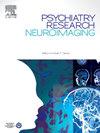氯卡色林对可卡因和阿片类药物使用障碍患者语义药物线索诱导的有效脑连通性的调节
IF 2.1
4区 医学
Q3 CLINICAL NEUROLOGY
引用次数: 0
摘要
了解药物线索反应的神经机制可以提高对药物使用障碍(sud)治疗靶点的认识。临床前研究表明,5-羟色胺(5-HT) 5-HT2A受体(5-HT2AR)和5-HT2CR系统显著影响复发易感性,但相反。具体来说,5-HT2AR拮抗剂和5-HT2CR激动剂可减少药物寻找行为和对药物线索的反应性。我们之前的神经影像学研究表明,米氮平(一种非选择性5-HT2AR拮抗剂)可以降低从前扣带皮层(ACC)到海马通路的有效连接(EC)。这一通路的EC一直被发现与sud患者对药物线索的注意偏向有关。为了扩展这一发现,我们研究了氯卡色林(一种5-HT2CR激动剂)对与药物相关线索引起的注意偏倚相关的EC的影响,通过对45名诊断为sud的个体在药物单词Stroop任务中获得的功能磁共振成像数据采用动态因果模型。我们观察到,在预处理基线时,ACC→海马EC与药物线索相关的注意偏倚呈微正相关。此外,与安慰剂相比,氯卡色林给药7天降低了ACC→海马EC。值得注意的是,这些EC结果不受手性、尿液中药物代谢物的存在、预处理尿液药物筛选和所用物质类型等因素的影响。该研究进一步证明了5 -羟色胺能调节ACC→海马EC,并且该EC可能是药物治疗sud的早期靶标参与信号。本文章由计算机程序翻译,如有差异,请以英文原文为准。
Lorcaserin modulation of semantic drug cue-elicited effective brain connectivity in persons with cocaine and opioid use disorders
Understanding the neural mechanisms of drug cue reactivity may improve understanding of therapeutic targets for substance use disorders (SUDs). Preclinical studies indicate that the serotonin (5-HT) 5-HT2A receptor (5-HT2AR) and 5-HT2CR systems considerably but oppositely impact relapse vulnerability. Specifically, 5-HT2AR antagonists and 5-HT2CR agonists reduce drug-seeking behavior and reactivity to drug cues. Our previous neuroimaging study showed that mirtazapine (a non-selective 5-HT2AR antagonist) can reduce the effective connectivity (EC) of the pathway from the anterior cingulate cortex (ACC) to the hippocampus. The EC of this pathway has been consistently found to be associated with attentional bias towards drug cues in individuals with SUDs. To extend this finding, we investigated the effect of lorcaserin (a 5-HT2CR agonist) on the EC linked to attentional bias elicited by drug-related cues by employing dynamic causal modeling on functional magnetic resonance imaging data acquired during a drug-word Stroop task performed by 45 individuals diagnosed with SUDs. We observed a marginally positive correlation between the ACC → hippocampus EC and drug cue-related attentional bias at the pretreatment baseline. Furthermore, compared to the placebo condition, 7-day administration of lorcaserin reduced the ACC → hippocampus EC. Notably, these EC outcomes remained unaffected by factors such as handedness, presence of drug metabolites in urine, pretreatment urine drug screen, and the type of substance used. This study contributes further evidence of serotonergic regulation of the ACC → hippocampus EC, and the potential for this EC to be an early signal of target engagement for medication to treat SUDs.
求助全文
通过发布文献求助,成功后即可免费获取论文全文。
去求助
来源期刊
CiteScore
3.80
自引率
0.00%
发文量
86
审稿时长
22.5 weeks
期刊介绍:
The Neuroimaging section of Psychiatry Research publishes manuscripts on positron emission tomography, magnetic resonance imaging, computerized electroencephalographic topography, regional cerebral blood flow, computed tomography, magnetoencephalography, autoradiography, post-mortem regional analyses, and other imaging techniques. Reports concerning results in psychiatric disorders, dementias, and the effects of behaviorial tasks and pharmacological treatments are featured. We also invite manuscripts on the methods of obtaining images and computer processing of the images themselves. Selected case reports are also published.

 求助内容:
求助内容: 应助结果提醒方式:
应助结果提醒方式:


